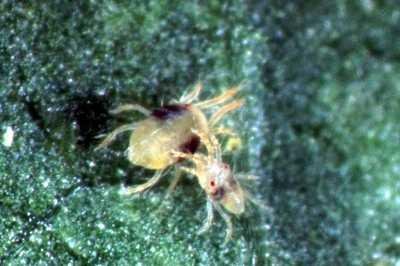(Oligonychus gossypii and Tetranychus spp.)
Credits: Biovision-Infonet

(c) Warwick HRI, University of Warwick
Several species of red spider mites also occur on cassava, mostly on the older leaves. Adults are about 0.6 mm long. Initial symptoms are yellowish pinpricks along the main vein of mature leaves. Spider mites produce protective webbing that can be readily seen on the plant. Attacked leaves turn reddish, brown or rusty in colour. Under severe mite attack, leaves die and drop beginning with older leaves. Most damage occurs at the beginning of the dry season.
What to do:
- Conserve natural enemies. Local natural enemies usually control these spider mites and no further control measures are needed.
- Avoid planting next to infested fields.
- Avoid use of broad-spectrum pesticides, in particular pyrethroids; this may lead to spider mite outbreaks.